Blog Archives
Ankle Sprains Are Common Foot Injuries
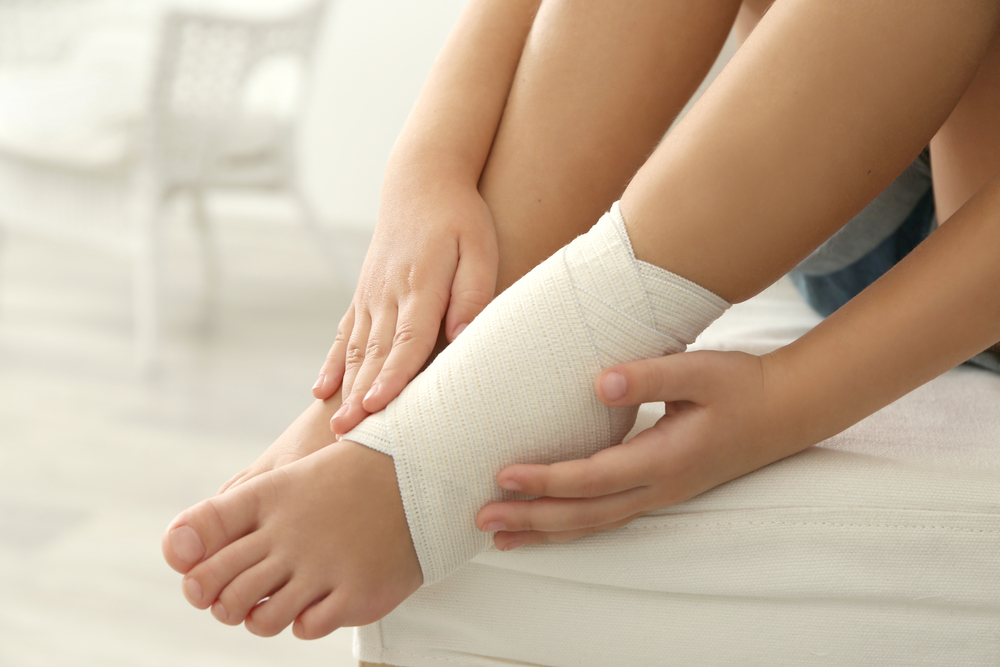 If you are involved in sporting activities, you may know that incurring an ankle injury is one of the more common mishaps to occur. This type of injury typically involves the ligaments of the ankle to twist or tear, and this generally produces severe pain and discomfort. Athletes that are involved in sports that require sudden jumping or running in small spurts may be more susceptible in acquiring this type of injury. These may include activities such as football, volleyball or basketball, in addition to general running. If a fall or a severe twisting of the foot should take place, obvious symptoms and signs may include sudden pain, a loud “snap”, bruising, or swelling. It’s suggested to speak with a podiatrist as quickly as possible for correct treatment options and to learn about future injury prevention.
If you are involved in sporting activities, you may know that incurring an ankle injury is one of the more common mishaps to occur. This type of injury typically involves the ligaments of the ankle to twist or tear, and this generally produces severe pain and discomfort. Athletes that are involved in sports that require sudden jumping or running in small spurts may be more susceptible in acquiring this type of injury. These may include activities such as football, volleyball or basketball, in addition to general running. If a fall or a severe twisting of the foot should take place, obvious symptoms and signs may include sudden pain, a loud “snap”, bruising, or swelling. It’s suggested to speak with a podiatrist as quickly as possible for correct treatment options and to learn about future injury prevention.
Ankle and foot injuries are common among athletes and in many sports. They can be caused by several problems and may be potentially serious. If you are feeling pain or think you were injured in a sporting event or when exercising, consult with Dr. Sharon Pletcher from Pennsylvania. Our doctor will assess your condition and provide you with quality foot and ankle treatment.
Common Injuries
The most common injuries that occur in sporting activities include:
- Achilles Tendonitis
- Achilles Tendon Rupture
- Ankle Sprains
- Broken Foot
- Plantar Fasciitis
- Stress Fractures
- Turf Toe
Symptoms
Symptoms vary depending upon the injury and in some cases, there may be no symptoms at all. However, in most cases, some form of symptom is experienced. Pain, aching, burning, bruising, tenderness, tightness or stiffness, sensation loss, difficulty moving, and swelling are the most common symptoms.
Treatment
Just as symptoms vary depending upon the injury, so do treatment options. A common treatment method is known as the RICE method. This method involves rest, applying ice, compression and elevating the afflicted foot or ankle. If the injury appears to be more serious, surgery might be required, such as arthroscopic or reconstructive surgery. Lastly, rehabilitation or therapy might be needed to gain full functionality in the afflicted area. Any discomfort experienced by an athlete must be evaluated by a licensed, reputable medical professional.
If you have any questions, please feel free to contact our office located in State College, PA. We offer the newest diagnostic and treatment technologies for all your foot care needs.
Read more about Sports Related Foot and Ankle InjuriesCauses of Cracked Heels
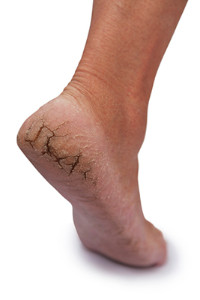 An uncomfortable and often painful foot condition known as cracked heels may occur for a variety of reasons. The most common cause is dry skin, which causes the cracks, also known as fissures, to develop. The skin may become dry for several reasons including standing for extended periods of time, specific skin conditions such as eczema, psoriasis, or athlete’s foot, and being overweight. An additional cause of cracked heels may come from wearing sandals that have an open back and these types of shoes may lack the support that is needed for healthy feet. If you have noticed that you have cracked skin on your heels, it’s suggested to wash the feet thoroughly followed by utilizing a good moisturizer, which may be more effective when used on damp skin. Please schedule a consultation with a podiatrist for a complete diagnosis in addition to discussing the best treatment options for you.
An uncomfortable and often painful foot condition known as cracked heels may occur for a variety of reasons. The most common cause is dry skin, which causes the cracks, also known as fissures, to develop. The skin may become dry for several reasons including standing for extended periods of time, specific skin conditions such as eczema, psoriasis, or athlete’s foot, and being overweight. An additional cause of cracked heels may come from wearing sandals that have an open back and these types of shoes may lack the support that is needed for healthy feet. If you have noticed that you have cracked skin on your heels, it’s suggested to wash the feet thoroughly followed by utilizing a good moisturizer, which may be more effective when used on damp skin. Please schedule a consultation with a podiatrist for a complete diagnosis in addition to discussing the best treatment options for you.
Cracked heels are unsightly and can cause further damage to your shoes and feet. If you have any concerns, contact Dr. Sharon Pletcher from Pennsylvania. Our doctor can provide the care you need to keep you pain-free and on your feet.
Cracked Heels
Cracked heels appear unappealing and can make it harder for you walk around in sandals. Aside from looking unpleasant, cracked heels can also tear stockings, socks, and wear out your shoes. There are several methods to help restore a cracked heel and prevent further damage.
How Do You Get Them?
Dry skin is the number one culprit in creating cracked heels. Many athletes, walkers, joggers, and even swimmers suffer from cracked heels. Age and skin oil production play a role to getting cracked heels as well.
Promote Healing
Over the counter medicines can help, especially for those that need instant relief or who suffer from chronic dry feet.
Wear Socks – Wearing socks with medicated creams helps lock in moisture.
Moisturizers – Applying both day and night will help alleviate dryness which causes cracking.
Pumice Stones – These exfoliate and remove dead skin, which allows for smoother moisturizer application and better absorption into the skin.
Change in Diet
Eating healthy with a well-balanced diet will give the skin a fresh and radiant look. Your body responds to the kinds of food you ingest. Omega-3 fatty acids and zinc supplements can also revitalize skin tissue.
Most importantly, seek professional help if unsure how to proceed in treating cracked heels. A podiatrist will help you with any questions or information needed.
If you have any questions, please feel free to contact our office located in State College, PA. We offer the newest diagnostic and treatment technologies for all your foot care needs.
Read more about Solutions for Cracked HeelsWhat You Should Know About Varicose Veins
 Varicose veins are a common problem for women across the world. The biggest risk factor for developing this condition is heredity. Surprisingly, over 80% of people who have varicose veins have them because of genetics. If you are looking for ways to reduce your risk of getting varicose veins, you should start by making lifestyle modifications. Maintaining an optimal weight, avoiding a sedentary lifestyle, and avoiding wearing tight clothes and heels are all ways you can reduce your risk of developing the disease. Although people consider this condition to be a cosmetic problem, it can also cause you to feel symptoms such as heaviness, pain, itching, swelling, burning, numbness, and cramps. If you have varicose veins in your lower extremities, such as the foot, you should consult with your podiatrist.
Varicose veins are a common problem for women across the world. The biggest risk factor for developing this condition is heredity. Surprisingly, over 80% of people who have varicose veins have them because of genetics. If you are looking for ways to reduce your risk of getting varicose veins, you should start by making lifestyle modifications. Maintaining an optimal weight, avoiding a sedentary lifestyle, and avoiding wearing tight clothes and heels are all ways you can reduce your risk of developing the disease. Although people consider this condition to be a cosmetic problem, it can also cause you to feel symptoms such as heaviness, pain, itching, swelling, burning, numbness, and cramps. If you have varicose veins in your lower extremities, such as the foot, you should consult with your podiatrist.
Vascular testing plays an important part in diagnosing disease like peripheral artery disease. If you have symptoms of peripheral artery disease, or diabetes, consult with Dr. Sharon Pletcher from Pennsylvania. Our doctor will assess your condition and provide you with quality foot and ankle treatment.
What Is Vascular Testing?
Vascular testing checks for how well blood circulation is in the veins and arteries. This is most often done to determine and treat a patient for peripheral artery disease (PAD), stroke, and aneurysms. Podiatrists utilize vascular testing when a patient has symptoms of PAD or if they believe they might. If a patient has diabetes, a podiatrist may determine a vascular test to be prudent to check for poor blood circulation.
How Is it Conducted?
Most forms of vascular testing are non-invasive. Podiatrists will first conduct a visual inspection for any wounds, discoloration, and any abnormal signs prior to a vascular test.
The most common tests include:
- Ankle-Brachial Index (ABI) examination
- Doppler examination
- Pedal pulses
These tests are safe, painless, and easy to do. Once finished, the podiatrist can then provide a diagnosis and the best course for treatment.
If you have any questions, please feel free to contact our office located in State College, PA. We offer the newest diagnostic and treatment technologies for all your foot care needs.
Read more about Vascular Testing in Podiatry
A Common Cause of Cuboid Syndrome
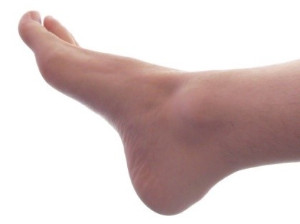 Pain is typically felt on the foot near the pinky toe if you are afflicted with cuboid syndrome. Additional symptoms that can be experienced may include the area appearing red, difficulty in walking due to a lack of mobility, or possible swelling. One of the most common causes of cuboid syndrome developing may be due to ankle sprains. This type of injury may put excessive pressure on the ligaments and ankle bones, possibly resulting in the cuboid bone dislocating and moving outward. If you are afflicted with this condition, you may find moderate relief in elevating your foot, which may aid in reducing swelling. It’s suggested to schedule a consultation with a podiatrist for additional information and treatment recommendations.
Pain is typically felt on the foot near the pinky toe if you are afflicted with cuboid syndrome. Additional symptoms that can be experienced may include the area appearing red, difficulty in walking due to a lack of mobility, or possible swelling. One of the most common causes of cuboid syndrome developing may be due to ankle sprains. This type of injury may put excessive pressure on the ligaments and ankle bones, possibly resulting in the cuboid bone dislocating and moving outward. If you are afflicted with this condition, you may find moderate relief in elevating your foot, which may aid in reducing swelling. It’s suggested to schedule a consultation with a podiatrist for additional information and treatment recommendations.
Cuboid syndrome, also known as cuboid subluxation, occurs when the joints and ligaments near the cuboid bone in the foot become torn. If you have cuboid syndrome, consult with Dr. Sharon Pletcher from Pennsylvania. Our doctor will assess your condition and provide you with quality foot and ankle treatment.
Cuboid syndrome is a common cause of lateral foot pain, which is pain on the outside of the foot. The condition may happen suddenly due to an ankle sprain, or it may develop slowly overtime from repetitive tension through the bone and surrounding structures.
Causes
The most common causes of cuboid syndrome include:
- Injury – The most common cause of this ailment is an ankle sprain.
- Repetitive Strain – Tension placed through the peroneus longus muscle from repetitive activities such as jumping and running may cause excessive traction on the bone causing it to sublux.
- Altered Foot Biomechanics – Most people suffering from cuboid subluxation have flat feet.
Symptoms
A common symptom of cuboid syndrome is pain along the outside of the foot which can be felt in the ankle and toes. This pain may create walking difficulties and may cause those with the condition to walk with a limp.
Diagnosis
Diagnosis of cuboid syndrome is often difficult, and it is often misdiagnosed. X-rays, MRIs and CT scans often fail to properly show the cuboid subluxation. Although there isn’t a specific test used to diagnose cuboid syndrome, your podiatrist will usually check if pain is felt while pressing firmly on the cuboid bone of your foot.
Treatment
Just as the range of causes varies widely, so do treatments. Some more common treatments are ice therapy, rest, exercise, taping, and orthotics.
If you have any questions, please feel free to contact our office located in State College, PA. We offer the newest diagnostic and treatment technologies for all your foot care needs.
Read more about Cuboid Syndrome
Gout Attack Prevention
 Years ago, gout was a condition that only the wealthy had to deal with. This is because the disease is often caused by an excessive intake of meat and alcohol, which only rich people could afford. This is because these foods are high in purines. Although the human body can produce purine on its own, eating purines creates something called uric acid. When the body has too much uric acid, gout starts to develop. The medical term for this occurrence is hyperuricemia. People who have gout should limit their purine intake, but this doesn’t necessarily mean you should eat more fruits and vegetables. Besides water, the best drink for people with gout is tea, because it breaks down purines quickly. Gout attacks can be painful. If you want to prevent them you should exercise on a daily basis. Exercising will help supply your joints with nutrients. If you are dealing with gout and need assistance on how to prevent gout attacks, it is best that you speak with your podiatrist.
Years ago, gout was a condition that only the wealthy had to deal with. This is because the disease is often caused by an excessive intake of meat and alcohol, which only rich people could afford. This is because these foods are high in purines. Although the human body can produce purine on its own, eating purines creates something called uric acid. When the body has too much uric acid, gout starts to develop. The medical term for this occurrence is hyperuricemia. People who have gout should limit their purine intake, but this doesn’t necessarily mean you should eat more fruits and vegetables. Besides water, the best drink for people with gout is tea, because it breaks down purines quickly. Gout attacks can be painful. If you want to prevent them you should exercise on a daily basis. Exercising will help supply your joints with nutrients. If you are dealing with gout and need assistance on how to prevent gout attacks, it is best that you speak with your podiatrist.
Gout is a painful condition that can be treated. If you are seeking treatment, contact Dr. Sharon Pletcher from Pennsylvania. Our doctor will treat your foot and ankle needs.
What is Gout?
Gout is a form of arthritis that is characterized by sudden, severe attacks of pain, redness, and tenderness in the joints. The condition usually affects the joint at the base of the big toe. A gout attack can occur at any random time, such as the middle of the night while you are asleep.
Symptoms
- Intense Joint Pain - Usually around the large joint of your big toe, and it most severe within the first four to twelve hours
- Lingering Discomfort - Joint discomfort may last from a few days to a few weeks
- Inflammation and Redness -Affected joints may become swollen, tender, warm and red
- Limited Range of Motion - May experience a decrease in joint mobility
Risk Factors
- Genetics - If family members have gout, you’re more likely to have it
- Medications - Diuretic medications can raise uric acid levels
- Gender/Age - Gout is more common in men until the age of 60. It is believed that estrogen protects women until that point
- Diet - Eating red meat and shellfish increases your risk
- Alcohol - Having more than two alcoholic drinks per day increases your risk
- Obesity - Obese people are at a higher risk for gout
Prior to visiting your podiatrist to receive treatment for gout, there are a few things you should do beforehand. If you have gout you should write down your symptoms--including when they started and how often you experience them, important medical information you may have, and any questions you may have. Writing down these three things will help your podiatrist in assessing your specific situation so that he or she may provide the best route of treatment for you.
If you have any questions, please feel free to contact our office located in State College, PA. We offer the newest diagnostic and treatment technologies for all your foot care needs.
Read more about GoutHow to Maintain Your Feet in the Summer
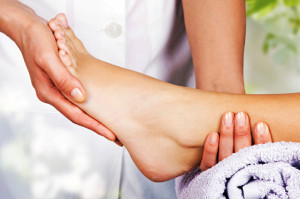 If you plan to be barefoot in public, you should make sure they look as healthy as possible. One of the best ways to achieve this is to exfoliate your feet to make them smooth and beautiful. Many people opt to do this by investing in a pumice stone to remove dead skin on their feet. The next thing you should do is ensure your feet are hydrated by applying a foot cream. If you want to have your feet professionally maintained, pedicures are a great way to do so. Salons are the ideal place to get your feet maintained in the summer, because nail professionals have the proper tools and skills to take care of your feet. If you want a natural nail color but still want your nails painted, you can try a light, flesh colored nail polish followed by a "mattifying" top coat. The result will give you natural looking nails that don’t appear to be painted. For any questions regarding foot care and maintenance, you shouldn't hesitate to contact your podiatrist.
If you plan to be barefoot in public, you should make sure they look as healthy as possible. One of the best ways to achieve this is to exfoliate your feet to make them smooth and beautiful. Many people opt to do this by investing in a pumice stone to remove dead skin on their feet. The next thing you should do is ensure your feet are hydrated by applying a foot cream. If you want to have your feet professionally maintained, pedicures are a great way to do so. Salons are the ideal place to get your feet maintained in the summer, because nail professionals have the proper tools and skills to take care of your feet. If you want a natural nail color but still want your nails painted, you can try a light, flesh colored nail polish followed by a "mattifying" top coat. The result will give you natural looking nails that don’t appear to be painted. For any questions regarding foot care and maintenance, you shouldn't hesitate to contact your podiatrist.
Everyday foot care is very important to prevent infection and other foot ailments. If you need your feet checked, contact Dr. Sharon Pletcher from Pennsylvania. Our doctor can provide the care you need to keep you pain-free and on your feet.
Everyday Foot Care
Often, people take care of their bodies, face and hair more so than they do for their feet. But the feet are a very important aspect of our bodies, and one that we should pay more attention to. Without our feet, we would not be able to perform most daily tasks.
It is best to check your feet regularly to make sure there are no new bruises or cuts that you may not have noticed before. For dry feet, moisturizer can easily be a remedy and can be applied as often as necessary to the affected areas. Wearing shoes that fit well can also help you maintain good foot health, as well as making it easier to walk and do daily activities without the stress or pain of ill-fitting shoes, high heels, or even flip flops. Wearing clean socks with closed shoes is important to ensure that sweat and bacteria do not accumulate within the shoe. Clean socks help to prevent Athlete’s foot, fungi problems, bad odors, and can absorb sweat.
If you have any questions please feel free to contact our office located in State College, PA. We offer the newest diagnostic and treatment technologies for all your foot and ankle needs.
Read more about Everyday Foot CareJets' Running Back Suffers Foot Fracture
 Eli McGuire of the New York Jets has been sidelined for the foreseeable future due to a broken foot. Recent news has emerged stating that the team's 2017 sixth-round draft pick will need surgery to repair the fracture. McGuire is expected to miss approximately three to six weeks of gameplay due to the injury. It was announced that the Jets have started to look for replacement running backs, which has led many to believe that they expect McGuire to miss a significant amount of time. The best case scenario for the Jets would be for McGuire’s injury to heal in the short end of the recovery window, which would allow him to return in time for the team’s third game of the season. If you have a foot fracture and are looking to explore your treatment options and recovery time frame, it is best to see a podiatrist right away.
Eli McGuire of the New York Jets has been sidelined for the foreseeable future due to a broken foot. Recent news has emerged stating that the team's 2017 sixth-round draft pick will need surgery to repair the fracture. McGuire is expected to miss approximately three to six weeks of gameplay due to the injury. It was announced that the Jets have started to look for replacement running backs, which has led many to believe that they expect McGuire to miss a significant amount of time. The best case scenario for the Jets would be for McGuire’s injury to heal in the short end of the recovery window, which would allow him to return in time for the team’s third game of the season. If you have a foot fracture and are looking to explore your treatment options and recovery time frame, it is best to see a podiatrist right away.
Foot surgery is sometimes necessary to treat a foot ailment. To learn more, contact Dr. Sharon Pletcher of Pennsylvania. Our doctor will assist you with all of your foot and ankle needs.
When Is Surgery Necessary?
Foot and ankle surgery is generally reserved for cases in which less invasive, conservative procedures have failed to alleviate the problem. Some of the cases in which surgery may be necessary include:
- Removing foot deformities like bunions and bone spurs
- Severe arthritis that has caused bone issues
- Cosmetic reconstruction
What Types of Surgery Are There?
The type of surgery you receive will depend on the nature of the problem you have. Some of the possible surgeries include:
- Bunionectomy for painful bunions
- Surgical fusion for realignment of bones
- Neuropathy decompression surgery to treat nerve damage
Benefits of Surgery
Although surgery is usually a last resort, it can provide more complete pain relief compared to non-surgical methods and may allow you to finally resume full activity.
Surgical techniques have also become increasingly sophisticated. Techniques like endoscopic surgery allow for smaller incisions and faster recovery times.
If you have any questions please feel free to contact our office located in State College, PA. We offer the newest diagnostic and treatment technologies for all your foot and ankle needs.
Read more about Foot SurgeryWhat are the Benefits of Exercising the Feet?
 When the muscles, tendons, and ligaments in the feet are strong, many foot conditions may possibly be avoided. These may include a common ailment referred to as plantar fasciitis, in addition to Achilles tendon injuries. Both of these conditions may cause pain and stiffness in the heel of the foot, which may often produce severe discomfort. An effective foot stretch can be performed by rolling the bottom of the foot over a foot roller or by using a frozen bottle of water. Rolling the foot back and forth about 10 times, may possibly alleviate achy feet. When the calf muscle is properly stretched, the Achilles tendon may typically gain the strength it needs to prevent painful injuries from occurring. This may be achieved by propping the ball of the foot against a wall, while the heel is on the ground. When a gentle stretch in the calf is felt by leaning into the wall, hold for 15 seconds, then repeat on the other foot. A consultation with a podiatrist is suggested to learn more about how exercises can help the feet.
When the muscles, tendons, and ligaments in the feet are strong, many foot conditions may possibly be avoided. These may include a common ailment referred to as plantar fasciitis, in addition to Achilles tendon injuries. Both of these conditions may cause pain and stiffness in the heel of the foot, which may often produce severe discomfort. An effective foot stretch can be performed by rolling the bottom of the foot over a foot roller or by using a frozen bottle of water. Rolling the foot back and forth about 10 times, may possibly alleviate achy feet. When the calf muscle is properly stretched, the Achilles tendon may typically gain the strength it needs to prevent painful injuries from occurring. This may be achieved by propping the ball of the foot against a wall, while the heel is on the ground. When a gentle stretch in the calf is felt by leaning into the wall, hold for 15 seconds, then repeat on the other foot. A consultation with a podiatrist is suggested to learn more about how exercises can help the feet.
Exercising your feet regularly with the proper foot wear is a great way to prevent injuries and build strength. If you have any concerns about your feet, contact Dr. Sharon Pletcher from Pennsylvania. Our doctor can provide the care you need to keep you pain-free and on your feet.
Exercise for Your Feet
Exercise for your feet can help you gain strength, mobility and flexibility in your feet. They say that strengthening your feet can be just as rewarding as strengthening another part of the body. Your feet are very important, and we often forget about them in our daily tasks. But it is because of our feet that are we able to get going and do what we need to. For those of us fortunate enough to not have any foot problems, it is an important gesture to take care of them to ensure good health in the long run.
Some foot health exercises can include ankle pumps, tip-toeing, toe rises, lifting off the floor doing reps and sets, and flexing the toes. It is best to speak with Our doctor to determine an appropriate regimen for your needs. Everyone’s needs and bodies are different, and the activities required to maintain strength in the feet vary from individual to individual.
Once you get into a routine of doing regular exercise, you may notice a difference in your feet and how strong they may become.
If you have any questions please feel free to contact our office located in State College, PA. We offer the newest diagnostic and treatment technologies for all your foot and ankle needs.
Read more about Exercise for Your FeetHow Can I Find Relief From My Arthritic Feet?
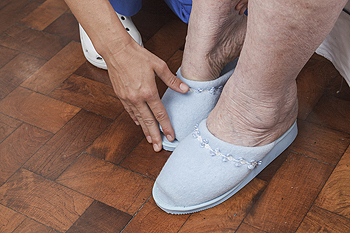 If you are afflicted with arthritic feet, you may find it difficult to perform certain activities, including walking. There is typically a moderate level of inflammation that surrounds the joints of the foot, which may produce considerable pain and discomfort. There are several different forms of arthritis which may affect the feet. If the cartilage begins to decay at the base of the toe, you may have what is referred to as osteoarthritis. This may contribute to other foot conditions such as bunions. Preventive measures may include choosing to wear wider shoes that do not put pressure on the bunion. Additionally, if the joints on the ball of the foot become inflamed, you may have rheumatoid arthritis. This may cause the bone to rub and push against the skin on the sole of the foot, which can often produce severe pain. A possible treatment option that may temporarily provide moderate relief involves attaching a long strip of leather to the bottom of the shoe behind the arch. This may aid in reducing a portion of the pressure that is often associated with this type of arthritis. It’s suggested to consult with a podiatrist to discuss further relief remedies and treatment protocols.
If you are afflicted with arthritic feet, you may find it difficult to perform certain activities, including walking. There is typically a moderate level of inflammation that surrounds the joints of the foot, which may produce considerable pain and discomfort. There are several different forms of arthritis which may affect the feet. If the cartilage begins to decay at the base of the toe, you may have what is referred to as osteoarthritis. This may contribute to other foot conditions such as bunions. Preventive measures may include choosing to wear wider shoes that do not put pressure on the bunion. Additionally, if the joints on the ball of the foot become inflamed, you may have rheumatoid arthritis. This may cause the bone to rub and push against the skin on the sole of the foot, which can often produce severe pain. A possible treatment option that may temporarily provide moderate relief involves attaching a long strip of leather to the bottom of the shoe behind the arch. This may aid in reducing a portion of the pressure that is often associated with this type of arthritis. It’s suggested to consult with a podiatrist to discuss further relief remedies and treatment protocols.
Arthritis can be a difficult condition to live with. If you are seeking treatment, contact Dr. Sharon Pletcher from Pennsylvania. Our doctor can provide the care you need to keep you pain-free and on your feet.
Arthritic Foot Care
Arthritis is a term that is commonly used to describe joint pain. The condition itself can occur to anyone of any age, race, or gender, and there are over 100 types of it. Nevertheless, arthritis is more commonly found in women compared to men, and it is also more prevalent in those who are overweight. The causes of arthritis vary depending on which type of arthritis you have. Osteoarthritis for example, is often caused by injury, while rheumatoid arthritis is caused by a misdirected immune system.
Symptoms
- Swelling
- Pain
- Stiffness
- Decreased Range of Motion
Arthritic symptoms range in severity, and they may come and go. Some symptoms stay the same for several years but could potentially get worse with time. Severe cases of arthritis can prevent its sufferers from performing daily activities and make walking difficult.
Risk Factors
- Occupation – Occupations requiring repetitive knee movements have been linked to osteoarthritis
- Obesity – Excess weight can contribute to osteoarthritis development
- Infection – Microbial agents can infect the joints and trigger arthritis
- Joint Injuries – Damage to joints may lead to osteoarthritis
- Age – Risk increases with age
- Gender –Most types are more common in women
- Genetics – Arthritis can be hereditary
If you suspect your arthritis is affecting your feet, it is crucial that you see a podiatrist immediately. Your doctor will be able to address your specific case and help you decide which treatment method is best for you.
If you have any questions, please feel free to contact our office located in State College, PA. We offer the newest diagnostic and treatment technologies for all your foot care needs.
Read more about Arthritic Foot CareAll About Stress Fractures
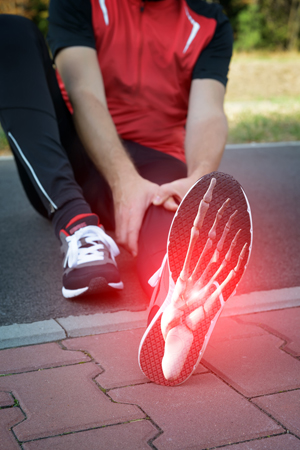 When runners develop stress fractures, they typically occur in the lower fibula and parts of the tibia. Stress fractures are a type of bone injury that occurs as a result of repetitive mechanical stress. Activities such as jumping and running can result in a stress fracture. If you are looking to treat your stress fracture, you should start by ceasing any high-impact activities and start to participate in cross-training activities. Cross-training is an exercise regimen that incorporates several modes of training to avoid overuse injuries. People who experience pain from walking with a stress fracture should look toward wearing a cast, boot, or crutches. Most athletes who suffer from stress fractures may gradually return to running within six to eight weeks. Training schedules, diet, and menstrual history are all factors that may increase your risk of developing a stress fracture.
When runners develop stress fractures, they typically occur in the lower fibula and parts of the tibia. Stress fractures are a type of bone injury that occurs as a result of repetitive mechanical stress. Activities such as jumping and running can result in a stress fracture. If you are looking to treat your stress fracture, you should start by ceasing any high-impact activities and start to participate in cross-training activities. Cross-training is an exercise regimen that incorporates several modes of training to avoid overuse injuries. People who experience pain from walking with a stress fracture should look toward wearing a cast, boot, or crutches. Most athletes who suffer from stress fractures may gradually return to running within six to eight weeks. Training schedules, diet, and menstrual history are all factors that may increase your risk of developing a stress fracture.
Activities where too much pressure is put on the feet can cause stress fractures. To learn more, contact Dr. Sharon Pletcher from Pennsylvania. Our doctor can provide the care you need to keep your pain free and on your feet.
Dealing with Stress Fractures of the Foot and Ankle
Stress fractures occur in the foot and ankle when muscles in these areas weaken from too much or too little use. The feet and ankles then lose support when walking or running from the impact of the ground. Since there is no protection, the bones receive the full impact of each step. Stress on the feet can cause cracks to form in the bones, thus creating stress fractures.
What Are Stress Fractures?
Stress fractures occur frequently in individuals whose daily activities cause great impact on the feet and ankles. Stress factors are most common among:
- Runners
- People affected with Osteoporosis
- Tennis or basketball players
- Gymnasts
- High impact workouts
Symptoms
Pain from the fractures occur in the area of the fractures and can be constant or intermittent. It will often cause sharp or dull pain with swelling and tenderness. Engaging in any kind of activity which involves high impact will aggravate pain.
If you have any questions please feel free to contact our office located in State College, PA. We offer the newest diagnostic and treatment technologies for all your foot and ankle needs.
Read more about Dealing with Stress Fractures of the Foot and AnkleMore...
Causes of Athlete’s Foot
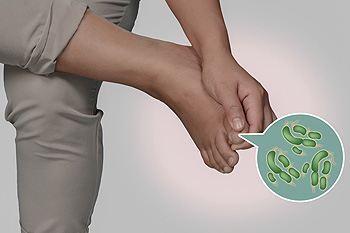 A fungal infection that develops in the skin of the feet, which may be referred to as athlete's foot or tinea pedis, often produces discomfort and pain. Probable symptoms may include itching and burning skin in addition to blisters that may form in between the toes. Athlete’s foot is typically caused by a fungus that thrives in warm and dark environments and may spread when the foot touches the contaminated area. This type of fungus often lives in public showers and pools, and may be prevented from spreading by wearing appropriate shoes in these areas. If you are affected by this condition, it may be beneficial to wash your feet often followed by thoroughly drying in between the toes. If your socks should become wet from excess moisture, it’s important to change them frequently in addition to wearing cotton socks which may aid in absorbing additional perspiration. For severe infections, a consultation with a podiatrist is advised for more aggressive treatment options
A fungal infection that develops in the skin of the feet, which may be referred to as athlete's foot or tinea pedis, often produces discomfort and pain. Probable symptoms may include itching and burning skin in addition to blisters that may form in between the toes. Athlete’s foot is typically caused by a fungus that thrives in warm and dark environments and may spread when the foot touches the contaminated area. This type of fungus often lives in public showers and pools, and may be prevented from spreading by wearing appropriate shoes in these areas. If you are affected by this condition, it may be beneficial to wash your feet often followed by thoroughly drying in between the toes. If your socks should become wet from excess moisture, it’s important to change them frequently in addition to wearing cotton socks which may aid in absorbing additional perspiration. For severe infections, a consultation with a podiatrist is advised for more aggressive treatment options
Athlete’s Foot
Athlete’s foot is often an uncomfortable condition to experience. Thankfully, podiatrists specialize in treating athlete’s foot and offer the best treatment options. If you have any questions about athlete’s foot, consult with Dr. Sharon Pletcher from Pennsylvania. Our doctor will assess your condition and provide you with quality treatment.
What Is Athlete’s Foot?
Tinea pedis, more commonly known as athlete’s foot, is a non-serious and common fungal infection of the foot. Athlete’s foot is contagious and can be contracted by touching someone who has it or infected surfaces. The most common places contaminated by it are public showers, locker rooms, and swimming pools. Once contracted, it grows on feet that are left inside moist, dark, and warm shoes and socks.
Prevention
The most effective ways to prevent athlete’s foot include:
- Thoroughly washing and drying feet
- Avoid going barefoot in locker rooms and public showers
- Using shower shoes in public showers
- Wearing socks that allow the feet to breathe
- Changing socks and shoes frequently if you sweat a lot
Symptoms
Athlete’s foot initially occurs as a rash between the toes. However, if left undiagnosed, it can spread to the sides and bottom of the feet, toenails, and if touched by hand, the hands themselves. Symptoms include:
- Redness
- Burning
- Itching
- Scaly and peeling skin
Diagnosis and Treatment
Diagnosis is quick and easy. Skin samples will be taken and either viewed under a microscope or sent to a lab for testing. Sometimes, a podiatrist can diagnose it based on simply looking at it. Once confirmed, treatment options include oral and topical antifungal medications.
If you have any questions, please feel free to contact our office located in State College, PA. We offer the newest diagnostic and treatment technologies for all your foot care needs.
Read more about Athlete's Foot
Symptoms and Causes of Sesamoiditis
 If an injury from overuse of the tendons in the foot should occur, it may be a condition known as sesamoiditis. The bones in the feet that are connected to the muscles are referred to as sesamoids, and the surrounding area may become inflamed and tender if an injury should happen. This is a condition that is commonly seen in athletes and ballet dancers, and may also develop as a result of wearing poorly fitting shoes or high heels. It’s important to obtain a proper diagnoses, and this can be accomplished by visiting a podiatrist who will check for tenderness around the ball of the foot. Treatment may begin with ceasing any activity that caused sesamoiditis. Research has shown the importance of keeping pressure off the sole of the foot in addition to elevating the affected foot. If extra cushioning is needed, please consult with a podiatrist for information about custom-made orthotics.
If an injury from overuse of the tendons in the foot should occur, it may be a condition known as sesamoiditis. The bones in the feet that are connected to the muscles are referred to as sesamoids, and the surrounding area may become inflamed and tender if an injury should happen. This is a condition that is commonly seen in athletes and ballet dancers, and may also develop as a result of wearing poorly fitting shoes or high heels. It’s important to obtain a proper diagnoses, and this can be accomplished by visiting a podiatrist who will check for tenderness around the ball of the foot. Treatment may begin with ceasing any activity that caused sesamoiditis. Research has shown the importance of keeping pressure off the sole of the foot in addition to elevating the affected foot. If extra cushioning is needed, please consult with a podiatrist for information about custom-made orthotics.
Sesamoiditis is an unpleasant foot condition characterized by pain in the balls of the feet. If you think you’re struggling with sesamoiditis, contact Dr. Sharon Pletcher of Pennsylvania. Our doctor will treat your condition thoroughly and effectively.
Sesamoiditis
Sesamoiditis is a condition of the foot that affects the ball of the foot. It is more common in younger people than it is in older people. It can also occur with people who have begun a new exercise program, since their bodies are adjusting to the new physical regimen. Pain may also be caused by the inflammation of tendons surrounding the bones. It is important to seek treatment in its early stages because if you ignore the pain, this condition can lead to more serious problems such as severe irritation and bone fractures.
Causes of Sesamoiditis
- Sudden increase in activity
- Increase in physically strenuous movement without a proper warm up or build up
- Foot structure: those who have smaller, bonier feet or those with a high arch may be more susceptible
Treatment for sesamoiditis is non-invasive and simple. Doctors may recommend a strict rest period where the patient forgoes most physical activity. This will help give the patient time to heal their feet through limited activity. For serious cases, it is best to speak with your doctor to determine a treatment option that will help your specific needs.
If you have any questions please feel free to contact our office located in State College, PA. We offer the newest diagnostic and treatment technologies for all your foot and ankle needs.
Read more about SesamoiditisTypes of Foot and Ankle Injuries
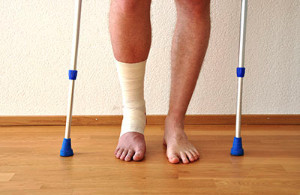 The ankle is considered to be one of the more stable joints in the body when compared to the body’s numerous other joints. When we walk, run, or jump, the ankle endures approximately one and a half times the weight of the body, and may become at risk for possible serious injury, while engaging in high-impact activities. Common ankle afflictions may include sprains, strains, Achilles tendon injuries, or fractures, which may all produce a significant amount of pain and discomfort. An acute injury may be experienced while stepping down from a curb before realizing it’s there. This occurs as a result of the ankle moving beyond its normal range of motion, which is typically caused by a severe twisting motion. A condition that is referred to as an ankle strain may develop as a result of repeated overuse of the ankle, and this is common among certain types of athletes. Please consult with a podiatrist for additional information about how foot and ankle injuries can be treated.
The ankle is considered to be one of the more stable joints in the body when compared to the body’s numerous other joints. When we walk, run, or jump, the ankle endures approximately one and a half times the weight of the body, and may become at risk for possible serious injury, while engaging in high-impact activities. Common ankle afflictions may include sprains, strains, Achilles tendon injuries, or fractures, which may all produce a significant amount of pain and discomfort. An acute injury may be experienced while stepping down from a curb before realizing it’s there. This occurs as a result of the ankle moving beyond its normal range of motion, which is typically caused by a severe twisting motion. A condition that is referred to as an ankle strain may develop as a result of repeated overuse of the ankle, and this is common among certain types of athletes. Please consult with a podiatrist for additional information about how foot and ankle injuries can be treated.
Foot and ankle trauma is common among athletes and the elderly. If you have concerns that you may have experienced trauma to the foot and ankle, consult with Dr. Sharon Pletcher from Pennsylvania. Our doctor will assess your condition and provide you with quality foot and ankle treatment.
Foot and ankle trauma cover a range of injuries all over the foot; common injuries include:
- Broken bones
- Muscle strains
- Injuries to the tendons and ligaments
- Stress fractures
Symptoms
Symptoms of foot and ankle injuries vary depending on the injury, but more common ones include:
- Bruising
- Inflammation/ Swelling
- Pain
Diagnosis
To properly diagnose the exact type of injury, podiatrists will conduct a number of different tests. Some of these include sensation and visual tests, X-rays, and MRIs. Medical and family histories will also be taken into account.
Treatment
Once the injury has been diagnosed, the podiatrist can than offer the best treatment options for you. In less severe cases, rest and keeping pressure off the foot may be all that’s necessary. Orthotics, such as a specially made shoes, or immobilization devices, like splints or casts, may be deemed necessary. Finally, if the injury is severe enough, surgery may be necessary.
If you have any questions, please feel free to contact our office located in State College, PA. We offer the newest diagnostic and treatment technologies for all your foot care needs.
Read more about Foot and Ankle TraumaHow Can I Tell If I’ve Broken My Toe?
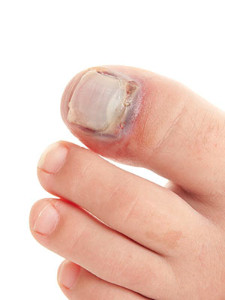 If you have suffered a broken toe, it is typically a result of an injury that has occurred or from a heavy object falling on the foot. Often, people may stub or jam their toe which may lead to the toe becoming fractured. There are several symptoms that are easily identifiable, including bruising, pain while walking, or a deformed look to the toe. In more severe fractures, the bone may protrude from the skin and the nail may become injured which may cause a subungual hematoma, often referred to as an open fracture. Typical treatment methods may consist of the toe being placed in a splint which prevents mobility to ensure proper healing. A simple fracture generally will heal completely in approximately six weeks but complications may develop such as arthritis, pain, and stiffness from a more severely broken toe. A podiatrist can properly diagnose a broken toe and it’s advised to schedule a consultation when the injury occurs.
If you have suffered a broken toe, it is typically a result of an injury that has occurred or from a heavy object falling on the foot. Often, people may stub or jam their toe which may lead to the toe becoming fractured. There are several symptoms that are easily identifiable, including bruising, pain while walking, or a deformed look to the toe. In more severe fractures, the bone may protrude from the skin and the nail may become injured which may cause a subungual hematoma, often referred to as an open fracture. Typical treatment methods may consist of the toe being placed in a splint which prevents mobility to ensure proper healing. A simple fracture generally will heal completely in approximately six weeks but complications may develop such as arthritis, pain, and stiffness from a more severely broken toe. A podiatrist can properly diagnose a broken toe and it’s advised to schedule a consultation when the injury occurs.
A broken toe can be very painful and lead to complications if not properly fixed. If you have any concerns about your feet, contact Dr. Sharon Pletcher from Pennsylvania. Our doctor will treat your foot and ankle needs.
What to Know About a Broken Toe
Although most people try to avoid foot trauma such as banging, stubbing, or dropping heavy objects on their feet, the unfortunate fact is that it is a common occurrence. Given the fact that toes are positioned in front of the feet, they typically sustain the brunt of such trauma. When trauma occurs to a toe, the result can be a painful break (fracture).
Symptoms of a Broken Toe
- Throbbing pain
- Swelling
- Bruising on the skin and toenail
- The inability to move the toe
- Toe appears crooked or disfigured
- Tingling or numbness in the toe
Generally, it is best to stay off of the injured toe with the affected foot elevated.
Severe toe fractures may be treated with a splint, cast, and in some cases, minor surgery. Due to its position and the pressure it endures with daily activity, future complications can occur if the big toe is not properly treated.
If you have any questions please feel free to contact our office located in State College, PA. We offer the newest diagnostic and treatment technologies for all your foot and ankle needs.
Read more about What to Know About a Broken Toe



